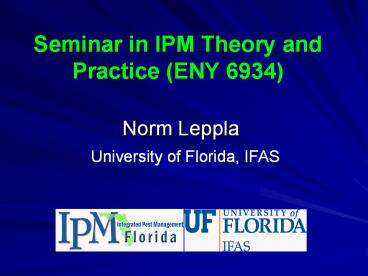Seminar in IPM Theory and Practice (ENY 6934) PowerPoint PPT Presentation
Title: Seminar in IPM Theory and Practice (ENY 6934)
1
Seminar in IPM Theory and Practice (ENY 6934)
- Norm Leppla
University of Florida, IFAS
2
Introduction to Integrated Pest Management (IPM)
- History of IPM
- What is IPM?
- IPM practices and applications
- Pest outbreaks and growers reaction
- IPM education, training and credentials
- Access to IPM information
- Future of IPM in Florida and elsewhere
3
IPM Partnerships
- State
- Regional
- National
4
What is IPM?
Integrated Pest Management, or IPM, is a
long-standing, science-based decision-making
process that identifies and reduces risks from
pests and pest management strategies. It
coordinates information on pest biology, the
environment, and available technology to prevent
unacceptable levels of pest damage by the most
economical means, while posing the least risk to
people, property, resources, and the environment.
IPM provides an effective strategy for managing
pests from developed agricultural, residential,
and public areas to wild lands. IPM provides an
effective, all encompassing, sustainable approach
to protect natural resources, crops, animals and
people from pests. IPM recommendations are
frequently recognized as Best Management
Practices (BMPs) to manage weeds, disease and
insects for production of food and fiber (USDA
National Road Map for Integrated Pest
Management).
5
IPM System Objectives
- Pest outbreaks disease epidemics
- Environmental contamination
- Human health hazards
- Pest mgmt. costs
- Reduce
- risk
- INCREASE
- Reliability
- Sustainability
Chem
Biological Control
Cultural Methods
6
IPM Practices
7
Generic IPM Program
- Biological knowledge
- Monitoring and inspection
- Act to control pests when necessary
- Choose least-risk options
- Long-term, preventative practices
- Evaluation and records
- Pesticide management
- Continual improvement
8
What Causes Pest Outbreaks?
- Alien invasive species
- Disrupted environments
- Pesticide resistance
- Local invasions
- Perceptions
- Others causes?
9
(No Transcript)
10
Disrupted Environments
1896 in Lobby Pool Room 400 people incorporated
Miami
Miami-Dade County Population 2-3 million
11
Pesticide Resistance
The (mistaway) system uses a bio-degradable
insecticide derived from the chrysanthemum flower
called pyrethrum.
12
Local Invasions
13
Perceptions
14
Growers Reaction to Outbreaks
15
Reaction to a New Pest
Alien Invasive Pest
- Resistant Crop
- Competitors
- Natural enemies
- Resistant varieties
Vulnerable Crop
- Integrated pest management program
- Cultural practices
- Scouting, Identification of pests and NE
- Conservation of natural enemies
- Augmentation of natural enemies
- Reduced-risk insecticides
- Resistance management
- Pesticide program
- Application methods
- Resistance management
- New pesticides
16
IPM for Florida Crops
Major Florida Crops Approx. Ac IPM Programs Lead IFAS Entomology Faculty IPM Asst.
Blueberry 10,134 X Liburd
Citrus (orchards) 576,577 X Rogers, Stansly X
Cotton 80,053 X ?
Corn (grain) 33,915 ? Nuessly
Corn (silage) 27,005 ? Nuessly
Corn (sweet) 29,000 ?, PMSP Nuessly
Grape 300 ? Liburd X
Melons 25,000 ?, PMSP Webb
Organic 5,974 X Swisher
Ornamental (woody) 35,000 X, PMSP Buss, Mizell X
Ornamental (GH SH) 40,000 ? Osborne, Mannion, Arthurs X
Pasture (forage) 354,860 ? ? X
Pasture (hay) 327,547 ? ?
Pecan 8,652 ? Mizell
Peppers (Field) 6,100 X Funderburk, Stansly X
Peanut 118,637 ? ?
Potato 27,200 ?, PMSP ?
Rice 11,376 ? ?
Snap bean 12,400 ? ?
Soybean 12,066 ? ?
Strawberry 7,500 X, PMSP Liburd, Price X
Sugarcane 378,587 ? Cherry
Tomato (Field) 35,000 X Funderburk, Stansly X
Tropical fruit 10,000 ?, PMSP Pena
Turf (Sod) 100,000 ? Buss X
Vegetables 224,837 X (PMSP) Stansly, Webb X
Vegetables (GH) 100 X (some) Osborne
17
Potential Threats to IPM Systems
- Loss of pesticides
- Offshore competition
- Damaging weather
- Population Growth
- Environmentalism
- Government assistance
18
Potential Threats to IPM Systems
- Food borne illnesses
- Land availability and use
- Labor and immigration
- Water quality and quantity
- Higher operating costs (fuel)
- New plant pests and diseases
19
IPM Florida provides statewide, interdisciplinary
and inter-unit coordination and assistance for
UF/IFAS integrated pest management research
Extension and education faculty

